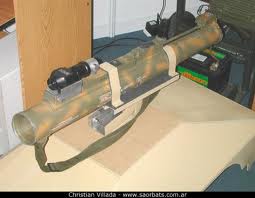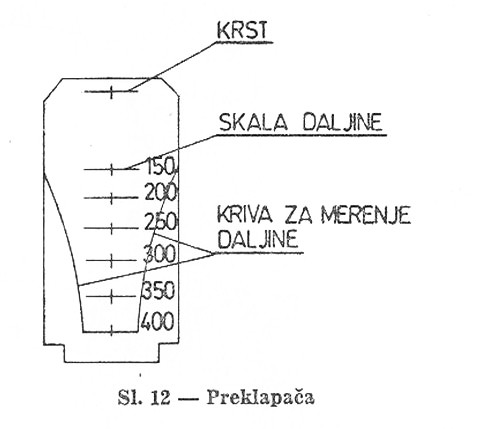|
MARA (anti-tank Weapon)
The MARA is a portable one-shot 78 mm unguided anti-tank weapon, designed and manufactured in Argentina by Fabricaciones Militares (DGFM). The solid rocket propulsion unit was developed by CITEFA. History In the 1990s, the Argentine Army identified the need to replace obsolete short-range infantry antitank weapons in use, Such as the PDEF-40 rifle grenade, with a modern weapon similar to the AT4 locally developed and built, The MARA Project was started by DGFM in the late 1990s, and in February 2005 the weapon was tested at the “Fábrica Militar Fray Luis Beltrán”. Description The MARA is a weapon of 78 mm caliber with a fiberglass launcher tube 70 cm in length when transported that is extended to 1 meter when ready to fire. The launcher weighs about 4.2 kg, can be reused up to five times when using training ammunition, and is disposable when firing live ammunition. The anti-tank projectile is fin-stabilized, and is propelled by the rocker m ... [...More Info...] [...Related Items...] OR: [Wikipedia] [Google] [Baidu] |
CITEFA Mara
The Institute of Scientific and Technical Research for Defense ( es, Instituto de Investigaciones Científicas y Técnicas para la Defensa, also known for its acronym CITEDEF), is an Argentine federal agency in charge of research and development in various scientific fields. It is also in charge of homologation of weaponry. Located in the Villa Martelli district of Greater Buenos Aires, CITEDEF is one of the scientific and technological organisms that depend on the Ministry of Defense and its Secretary of Planning. It is also a part of the "Constituyentes Technological Hub" along with other institutions such as the Atomic Energy National Commission (CNEA), the University of San Martín (UNSAM) and the National Institute of Industrial Technology (INTI), among others. CITEDEF currently develops a series of projects that give it an edge on research and technology at a regional level. It is the first link of the productive chain within the Production Industry for Defense through the ... [...More Info...] [...Related Items...] OR: [Wikipedia] [Google] [Baidu] |
Anti-tank Rockets
Anti-tank warfare originated from the need to develop technology and tactics to destroy tanks during World War I. Since the Triple Entente deployed the first tanks in 1916, the German Empire developed the first anti-tank weapons. The first developed anti-tank weapon was a scaled-up bolt-action rifle, the Mauser 1918 T-Gewehr, that fired a 13mm cartridge with a solid bullet that could penetrate the thin armor of tanks of the time and destroy the engine or ricochet inside, killing occupants. Because tanks represent an enemy's strong force projection on land, military strategists have incorporated anti-tank warfare into the doctrine of nearly every combat service since. The most predominant anti-tank weapons at the start of World War II in 1939 included the tank-mounted gun, anti-tank guns and anti-tank grenades used by the infantry, and ground-attack aircraft. Anti-tank warfare evolved rapidly during World War II, leading to the inclusion of infantry-portable weapons such as t ... [...More Info...] [...Related Items...] OR: [Wikipedia] [Google] [Baidu] |
RPG-76
RPG-76 Komar ( eng. ''Mosquito'') is a disposable one-shot anti-tank grenade launcher that fires an unguided anti-tank rocket-propelled grenade. The weapon was designed as a smaller and lighter alternative to the RPG-7, especially for use by airborne troops. Thanks to jet nozzles located between the warhead and the fuel compartment, it can be fired from inside of a building or a vehicle. Design phase In 1971 in the Polish Military Institute of Defense Technology a program codenamed “Argon” was begun. The goal of the project was to develop an anti-tank grenade launcher with a single use launch tube, which could supplement the RPG-7 launcher. Two versions were considered: a recoilless rifle and a rocket-propelled grenade launcher. The rocket variant was chosen because earlier experience gained during the development of the rocket assisted PGN-60 rifle grenade used by the Carbine-grenade launcher Kbkg wz. 1960. At this stage apart from the team of Polish scientists (Z.Zborows ... [...More Info...] [...Related Items...] OR: [Wikipedia] [Google] [Baidu] |
RPG-22
The Soviet RPG-22 ''Netto'' is a one-shot disposable anti-tank rocket launcher first deployed in 1985, based on the RPG-18 rocket launcher, but firing a larger 72.5 mm fin stabilised projectile. The weapon fires an unguided projectile, can be prepared to fire in around 10 seconds, and can penetrate 400 mm of armour, 1.2 metres of brick or 1 metre of reinforced concrete. Operation The smoothbore container is made from two fibreglass parts; a main tube containing the rocket, and a telescoping forward extension, which slides over the barrel. In transport mode, both ends of the barrel are closed by plastic covers, which open when the weapon is extended. The firing mechanism is manually cocked by raising the rear sight. Lowering the rear sight de-cocks the weapon if there is no target. On firing, there is a backblast danger area behind the weapon, of at least 15 metres. The solid propellant motor completely burns out while the rocket is still in the barrel tube, accel ... [...More Info...] [...Related Items...] OR: [Wikipedia] [Google] [Baidu] |
RPG-18
The RPG-18 Mukha (russian: Муха, translit=Fly) is a Soviet short-range, disposable light anti-tank rocket launcher designed in 1972. History The RPG-18 is very similar to the US M72-series LAW anti-tank rocket launcher. The RPG-18 has been succeeded by the RPG-22, a very similar design with a larger warhead. Description The RPG-18 fires a 64 mm ''PG-18'' high-explosive anti-tank (HEAT) warhead mounted on a small rocket able to engage targets within 200 meters. The warhead self-destructs six seconds after launch, placing a limit on range even if a sight was used that was effective with targets beyond 200 meters. The RPG-18 can penetrate up to 375 mm of conventional armor. However, performance is significantly lessened when the RPG-18 is used against targets protected by HEAT-resistant explosive reactive armour (ERA) or composite armor. Unlike better known weapons, the RPG-18 requires only one operator because it is not reloadable. Assistant grenadiers are used ... [...More Info...] [...Related Items...] OR: [Wikipedia] [Google] [Baidu] |
M80 Rocket Launcher
The M80 Zolja ( sr, Зоља, Zolja; "wasp") is a portable one-shot disposable 64 mm unguided anti-tank rocket-propelled grenade, designed in the former Yugoslavia. The M80 Zolja is still produced in Serbia and in North Macedonia. Description Constructed from fibre-reinforced plastics, the M80 Zolja is designed to be used by an individual against armoured fighting vehicles or fortifications. The M80 Zolja is a single-use recoilless weapon which is characterized by its simple operation and lightweight characteristics. The launcher and the container are incorporated into a single unit. The M80 Zolja is similar to the American M72 LAW in both appearance and performance. Launcher The M80 Zolja launcher is telescoping which is intended for easier transportation. The launchers consists of a forward and rear tube made of fibre-reinforced plastic, a firing mechanism, front and rear aiming sights, a carry handle, front and rear caps to keep debris out and a sling. Rocket The ... [...More Info...] [...Related Items...] OR: [Wikipedia] [Google] [Baidu] |
M72 LAW
The M72 LAW (light anti-tank weapon, also referred to as the light anti-armor weapon or LAW as well as LAWS: light anti-armor weapons system) is a portable one-shot unguided anti-tank weapon. The solid rocket propulsion unit was developed in the newly-formed Rohm and Haas research laboratory at Redstone Arsenal in 1959, and the full system was designed by Paul V. Choate, Charles B. Weeks, Frank A. Spinale, et al. at the Hesse-Eastern Division of Norris Thermadore. American production of the weapon began by Hesse-Eastern in 1963, and was terminated by 1983; currently it is produced by Nammo Raufoss AS in Norway and their subsidiary, Nammo Talley, Inc. in Arizona. In early 1963, the M72 LAW was adopted by the U.S. Army and U.S. Marine Corps as their primary individual infantry anti-tank weapon, replacing the M31 HEAT rifle grenade and the M20A1 "super bazooka" in the U.S. Army. It was subsequently adopted by the U.S. Air Force to serve in an anti-emplacement and anti-armor ... [...More Info...] [...Related Items...] OR: [Wikipedia] [Google] [Baidu] |
Argentine Army
The Argentine Army ( es, Ejército Argentino, EA) is the land force branch of the Armed Forces of the Argentine Republic and the senior military service of Argentina. Under the Argentine Constitution, the president of Argentina is the commander-in-chief of the Armed Forces, exercising his or her command authority through the Minister of Defense. The Army's official foundation date is May 29, 1810 (celebrated in Argentina as the ''Army Day''), four days after the Spanish colonial administration in Buenos Aires was overthrown. The new national army was formed out of several pre-existing colonial militia units and locally manned regiments; most notably the Infantry Regiment "Patricios", which to this date is still an active unit. , the active element of the Argentine Army numbered some 70,600 military personnel. History Several armed expeditions were sent to the Upper Peru (now Bolivia), Paraguay, Uruguay and Chile to fight Spanish forces and secure Argentina's newly gained ... [...More Info...] [...Related Items...] OR: [Wikipedia] [Google] [Baidu] |
Anti-tank
Anti-tank warfare originated from the need to develop technology and tactics to destroy tanks during World War I. Since the Triple Entente deployed the first tanks in 1916, the German Empire developed the first anti-tank weapons. The first developed anti-tank weapon was a scaled-up bolt-action rifle, the Mauser 1918 T-Gewehr, that fired a 13mm cartridge with a solid bullet that could penetrate the thin armor of tanks of the time and destroy the engine or ricochet inside, killing occupants. Because tanks represent an enemy's strong force projection on land, military strategists have incorporated anti-tank warfare into the doctrine of nearly every combat service since. The most predominant anti-tank weapons at the start of World War II in 1939 included the tank-mounted gun, anti-tank guns and anti-tank grenades used by the infantry, and ground-attack aircraft. Anti-tank warfare evolved rapidly during World War II, leading to the inclusion of infantry-portable weapons such as ... [...More Info...] [...Related Items...] OR: [Wikipedia] [Google] [Baidu] |
CITEFA
The Institute of Scientific and Technical Research for Defense ( es, Instituto de Investigaciones Científicas y Técnicas para la Defensa, also known for its acronym CITEDEF), is an Argentine federal agency in charge of research and development in various scientific fields. It is also in charge of homologation of weaponry. Located in the Villa Martelli district of Greater Buenos Aires, CITEDEF is one of the scientific and technological organisms that depend on the Ministry of Defense and its Secretary of Planning. It is also a part of the "Constituyentes Technological Hub" along with other institutions such as the Atomic Energy National Commission (CNEA), the University of San Martín (UNSAM) and the National Institute of Industrial Technology (INTI), among others. CITEDEF currently develops a series of projects that give it an edge on research and technology at a regional level. It is the first link of the productive chain within the Production Industry for Defense through the ... [...More Info...] [...Related Items...] OR: [Wikipedia] [Google] [Baidu] |
Solid Rocket
A solid-propellant rocket or solid rocket is a rocket with a rocket engine that uses solid propellants ( fuel/ oxidizer). The earliest rockets were solid-fuel rockets powered by gunpowder; they were used in warfare by the Arabs, Chinese, Persians, Mongols, and Indians as early as the 13th century. All rockets used some form of solid or powdered propellant up until the 20th century, when liquid-propellant rockets offered more efficient and controllable alternatives. Solid rockets are still used today in military armaments worldwide, model rockets, solid rocket boosters and on larger applications for their simplicity and reliability. Since solid-fuel rockets can remain in storage for an extended period without much propellant degradation and because they almost always launch reliably, they have been frequently used in military applications such as missiles. The lower performance of solid propellants (as compared to liquids) does not favor their use as primary propu ... [...More Info...] [...Related Items...] OR: [Wikipedia] [Google] [Baidu] |






